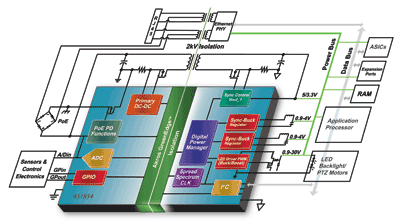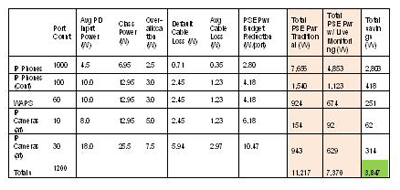Integrated digital isolation drives intelligent power
Power can now be allocated much as data bandwidth is today
BY AMIT GATTANI
Akros Silicon, Folsom, CA
http://www.akrossilicon.com
The advent of Power over Ethernet (PoE) has enabled powering network devices via the same Ethernet cable used for data. This sharing capability eliminates the need to provide a wall-wart power cube and power outlet for each device, thereby consolidating network power at the power-sourcing equipment (PSE). While the new IEEE 802.3at standard is best known for its increased power maximum (from 13 to 25.5 W), perhaps its most enterprise-friendly feature is the added control functionality that allows for dynamic allocation of per-port power device (PD) power by the PSE. Power can now be allocated much as data bandwidth is today.
Taking full advantage of these new energy-saving, power-allocation capabilities requires accurate, real-time measurement of PD power usage. The Akros AS1854 PoE system-on-a-chip (SoC) with an integrated isolation barrier allows PDs to gather this power data in real time, enabling allocation of network power at the data center. High-speed on-chip communication across the 2-kV isolation barrier makes this implementation practical, low cost, and seamless for system designers.
Network power
PoE by itself helps enterprises with improved power use by aggregating the power of multiple edge-devices into one unified power supply at the network switch. This approach eliminates large numbers of always-active inefficient wall adapters and offers lower cost, a simplified infrastructure, and backup power management — all tremendous benefits for enterprises. However, with aggregation of power at the network switch, energy consumption density in the data center increases, leading to more cooling challenges and its resulting impact on enterprise energy costs.
To reduce energy consumption in the enterprise, it’s critical to focus on all aspects of energy: usage, allocation, and management. Any commodity consumption can be optimized when closed-loop measurements can drive appropriate allocation and usage decisions. This power consumption data exchange between the PSE and PD is done over well-established Ethernet data-link layer communication protocol, known as LLDP (link layer discovery protocol), as defined in the IEEE 802.3at standard. This capability allows designers building PoE systems to budget power and match total system power capabilities to system load requirements much more closely.
High-speed digital isolation
Inclusion of a high-speed 2-kV digital isolation barrier into next-generation PoE PD power conversion technology (for example, the Akros AS1854) can deliver groundbreaking power integration, and enable a new range of digital power PoE PD capabilities and solutions. By integrating multiple flexible dc/dc outputs into one power SoC, including digital isolation, next-generation ICs simplify PoE PD system design while delivering benefits of power-system efficiency and intelligent management (see Fig. 1 ).

Fig. 1. Example of a complete PoE and power management solution: Akros Silicon’s AS1854 integrates Type 1 (IEEE 802.3af) and Type 2 (IEEE pre-802.3at)-compliant PDs, high-voltage isolation, and quad-output digital power dc/dc converters in a single device requiring minimal external components and no optocouplers.
In addition to enabling digital PoE power conversion, high-speed digital isolation enables direct digital management of both isolated primary power and secondary system power. Direct digital communication across the 2-kV electrical isolation barrier allows real-time and accurate power consumption information from the high-voltage side to be available to the system software.
Isolated communication channels can be accomplished with discrete components such as optocouplers, but they tend to be slow, bulky, and expensive, making the design more costly, much larger, and often impractical. Integrated high-voltage power management provides a unique opportunity for power-control innovation for real-time end-to-end Green Power application capabilities.
On-chip digital isolation is the driving factor for energy management. Integrated isolation enables stand-alone efficiency improvements in the PD power subsystem by managing PWM timing to eliminate PWM overlap losses and deliver superior light-load to full-load efficiency. Integrating an isolated ADC allows for direct power usage monitoring by the PD’s microcontroller across the isolation barrier.
This live-monitoring feature collects real-time power usage to pass to the PSE’s network management software. PSEs can accurately deduce cable losses by subtracting the PD’s reported input power consumption from the known power delivered. Since average Ethernet cable length in the enterprise is significantly less than 100 m, substantial power savings can be achieved by knowledge of PD cable distance and by removing excessive allocation at the PSE.
The benefits of the live-monitoring feature include reduction of per-port power allocation based on real data, dynamic reallocation of power based on system use profiles, and smaller PSE power supplies required to fulfill the actual power demands all of which reduce energy density in the data center.
Managing enterprise energy
Table 1 shows a sample analysis and impact of live monitoring on a 1,000-person enterprise using network powered devices like IP phones, Wireless Access Points and IP cameras. The analysis shows how live monitoring can reduce the PSE power requirements from 11.2 to 7.4 kW, yielding substantial savings of 35%. Appropriate sizing of the power supply based on intelligent closed-loop system further reduces wastage of power and conversion to heat in the data center.

Integrated high-speed digital isolation facilitates primary-side power measurements and provides PDs with a cost-effective means of communicating their real-time power requirements to enterprise energy management software. The benefit of this approach is the ability for remote closed-loop intelligent control of PD energy demand and realistic PSE power allocation, making network-based energy management a practical reality. ■
Advertisement
Learn more about Akros Silicon





